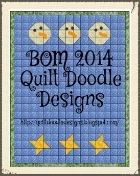I'm starting a new class tomorrow night, and I think the teacher may be pretty tough. It's an embroidery class, and look at this list of stuff we have to bring!
Well, I got the list out today and started looking it over and gathering up what I had. And near the top of that list is a 3-ring binder--and writing paper, dividers, and clear plastic pockets--just like "real" school! And, just like "real" students, I wanted to go back to school with cool new stuff that would make me the envy of every other student. So I decided to make myself a binder cover. And I figured I'd show you how, just in case you ever find yourself wanting to be the coolest kid in class.
The first step is to layer a backing fabric and batting, just like you would a quilt. The backing and batting should measure 13" wide x 40" long. In addition, you'll need a bunch of fabric strips 14" long by 2-1/2" wide or less. Because I'm basically willing to take the easiest route, I pulled out a bunch of precut 2-1/2" strips in the colors I needed. You'll also need an orphan quilt block that measures 13" in height--or you could just do it all in strips, but I like the block idea.
Anyway, as I said, layer the backing and batting fabric. Position your orphan block about 8" from the left edge. Pin the block and layers in place.
If you want to keep your strips going straight, draw pencil lines on the batting every 3" or 4" as a reference. (I drew my lines but then I decided to sew my strips on a little wonky so I mostly ignored them.)
Start sewing strips on each side of your orphan block. Do this by placing the strip right side down on the edge of the block and sew a seam. With your iron, press back the strip. Sew the next strip. Press. And so on, and so on . . . until you cover the batting and backing with strips.
Next, go back and add some quilting in your orphan block to secure the layers. Trim the tops and bottoms of the strips so the edges are even all along the cover. It should look something like this:
At this point, you'll need to get your binder out and fit the cover. Lay the cover on a desk or table, "good" side down. Open the binder and lay it on the cover. Position the left edge of the binder on the left edge of the cover and check the position of your orphan block--it should be centered on the back of the binder cover. Bring the right side of the cover up around to the front of the binder. I'm not sure how to explain this except to say that eventually, the front of your binder will look something like this--see how it comes up and wraps over the top?
Once you're satisfied with the position of the cover around the binder, trim the excess length from the cover. Don't toss out the excess--you'll use it next. From that excess, cut a length about 4" wide. It will be sewn on to the left edge of the binder cover as a pocket to slide the binder into.
You'll need to "finish" the right edge of that piece--I used a leftover fabric strip, turned the rough edges into the center, folded it down the center, pinned it in place, and sewed it by machine. Here's a closer view:
Now, you'll also need a "slide" to hold the right side of the binder in place. Same thing--use a leftover piece of the cover that you trimmed off. "Finish" or bind both edges of this piece. (I hadn't made my cover long enough to have a second leftover piece, so I just wrapped some fabric around a piece of batting, turned under the raw edge, and sewed through the layers to secure.)
Now, about that curved edge that wraps to the front of the binder. I just used a large dinner plate and traced the curve. The diameter was a little smaller than the cover, but I just extended the curved lines to meet the top and bottom edges. Once I was happy with the curve, I trimmed away the excess.
Now that you have all the pieces made, you can pin or baste the pocket and slide pieces in place. If you want to use a button as a closure on the front (see photo of binder front back up there a bit), then you'll also need to pin a loop of ribbon, rick rack, or whatever you'd like to use at the center of that curved edge in the photo above. Pin the ends at the edge of the cover with the loop or tying ends oriented away from the edge.
Okay, the last step is the binding. I recommend using bias binding for this project because it will lay nicer and sew easier around the curved edge. Add the binding as you would a quilt, covering the "raw" outside edges of the binder cover. Sewing on the binding will also secure the pocket, slide, and loop. Finally, try the cover on the binder and decide where to place your button. Done!
And since you've already seen the front of my binder cover, here's the back.
What do you think? Am I going to be the coolest kid in class tomorrow night, or what?!

































































